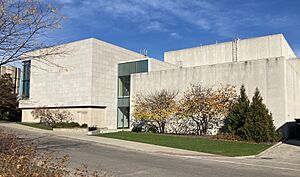- This page was last modified on 9 August 2025, at 08:36. Suggest an edit.
Theatre & Interpretation Center facts for kids
 |
|
| Former names | Northwestern University Theatre & Interpretation Center |
|---|---|
The Northwestern University Virginia Wadsworth Wirtz Center for the Performing Arts is a special place for shows and performances. It works with the Northwestern University School of Communication. Its main job is to create, manage, and fund all the amazing plays, musicals, and dance shows.
The Wirtz Center helps bring to life performances from the university's Department of Theatre and Department of Performance Studies. This includes all kinds of shows, like plays, music theatre, and dance performances.
The building was first built in 1980. It was known as the Northwestern University Theatre & Interpretation Center for many years. In 2015, it was given its current name.
Inside the Wirtz Center, there are many different spaces for performances. There's a large 450-seat theater called the Ethel M. Barber Theater. It has a thrust stage, which means the audience sits on three sides of the stage. There's also the Josephine Louis Theater, which seats 350 people and has a traditional proscenium stage. This is where the audience faces the stage from the front.
The center also has two smaller "black box" theaters. These are flexible spaces that can be set up in many ways. There's a special space for dance performances too. The building also has all the facilities needed to create theatrical productions. This includes workshops for sets and costumes, plus offices for the center's staff.
Some students at Northwestern University gave the building a funny nickname. Because of its simple white walls and boxy shape, they called it "The Box The Library Came In." This is because it looks very different from the fancy University Library nearby.
Contents
Exciting Productions and Shows
Each year, the Wirtz Center puts on many different shows. Sometimes, as many as forty productions are staged there. About eight of these are "main stage" productions. These are big shows performed in the Ethel M. Barber Theater and the Josephine Louis Theater.
Who Directs the Shows?
These main stage productions are directed by different people. Some are directed by university faculty members. Others are directed by students who are studying to become directors. Sometimes, special guest artists are invited to direct shows too.
What Kinds of Performances?
The shows include a mix of classic plays and new, modern ones. You can also see exciting dance performances and lively musical productions. There's always something interesting happening at the Wirtz Center.
Special Annual Shows
The Wirtz Center also produces some very popular annual events. One is the Waa-Mu Show. This is a special musical that is completely written and performed by students. It's a big tradition at Northwestern University.
Another popular event is Summerfest. This is a series of two or three plays performed during the summer months. It's a great way to enjoy theater when school is out.
Getting Tickets and Subscriptions
The center offers subscriptions for the entire season of shows. You can also buy subscriptions just for Summerfest. Many people enjoy these packages. Currently, over 1,500 people buy season tickets. These audience members come from the university and the nearby communities.
